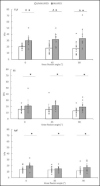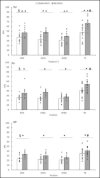Thoracolumbar Fascia and Lumbar Muscle Stiffness in Athletes with A History of Hamstring Injury
- PMID: 38841644
- PMCID: PMC11149066
- DOI: 10.52082/jssm.2024.436
Thoracolumbar Fascia and Lumbar Muscle Stiffness in Athletes with A History of Hamstring Injury
Abstract
The purpose of this study was to examine the differences in thoracolumbar fascia (TLF) and lumbar muscle modulus in individuals with and without hamstring injury using shear wave elastography (SWE). Thirteen male soccer players without a previous hamstring injury and eleven players with a history of hamstring injury performed passive and active (submaximal) knee flexion efforts from 0°, 45° and 90° angle of knee flexion as well as an active prone trunk extension test. The elastic modulus of the TLF, the erector spinae (ES) and the multifidus (MF) was measured using ultrasound SWE simultaneously with the surface electromyography (EMG) signal of the ES and MF. The TLF SWE modulus was significantly (p < 0.05) higher in the injured group (range: 29.86 ± 8.58 to 66.57 ± 11.71 kPa) than in the uninjured group (range: 17.47 ± 9.37 to 47.03 ± 16.04 kPa). The ES and MF modulus ranged from 14.97 ± 4.10 to 66.57 ± 11.71 kPa in the injured group and it was significantly (p < .05) greater compared to the uninjured group (range: 11.65 ± 5.99 to 40.49 ± 12.35 kPa). TLF modulus was greater than ES and MF modulus (p < 0.05). Active modulus was greater during the prone trunk extension test compared to the knee flexion tests and it was greater in the knee flexion test at 0° than at 90° (p < 0.05). The muscle EMG was greater in the injured compared to the uninjured group in the passive tests only (p < 0.05). SWE modulus of the TLF and ES and MF was greater in soccer players with previous hamstring injury than uninjured players. Further research could establish whether exercises that target the paraspinal muscles and the lumbar fascia can assist in preventing individuals with a history of hamstring injury from sustaining a new injury.
Keywords: Biceps femoris strain; Spine; injured hamstring; myofascial.
© Journal of Sports Science and Medicine.
Figures




Similar articles
-
Fascia and Muscle Stiffness in Soccer Athletes with and Without Previous Hamstring Injury.J Funct Morphol Kinesiol. 2025 Jan 28;10(1):48. doi: 10.3390/jfmk10010048. J Funct Morphol Kinesiol. 2025. PMID: 39982288 Free PMC article.
-
Paraspinal Muscle Stiffness during Hamstring Exercise Using Shear-Wave Elastography.Sports (Basel). 2024 Jul 23;12(8):199. doi: 10.3390/sports12080199. Sports (Basel). 2024. PMID: 39195575 Free PMC article.
-
Is thoracolumbar fascia shear-wave modulus affected by active and passive knee flexion?J Anat. 2024 Mar;244(3):438-447. doi: 10.1111/joa.13977. Epub 2023 Nov 15. J Anat. 2024. PMID: 37965913 Free PMC article.
-
Influence of thoracolumbar fascia stretching on lumbar back muscle stiffness: A supersonic shear wave elastography approach.Clin Anat. 2019 Jan;32(1):73-80. doi: 10.1002/ca.23266. Clin Anat. 2019. PMID: 30144317
-
Hamstring Muscle Stiffness During Isometric Contractions Until Task Failure in Footballers With and Without Injury History.J Strength Cond Res. 2025 May 1;39(5):e659-e667. doi: 10.1519/JSC.0000000000005061. Epub 2025 Mar 4. J Strength Cond Res. 2025. PMID: 40030099
Cited by
-
Fascia and Muscle Stiffness in Soccer Athletes with and Without Previous Hamstring Injury.J Funct Morphol Kinesiol. 2025 Jan 28;10(1):48. doi: 10.3390/jfmk10010048. J Funct Morphol Kinesiol. 2025. PMID: 39982288 Free PMC article.
References
-
- Al Attar W.S.A., Husain M.A. (2023) Effectiveness of Injury Prevention Programs With Core Muscle Strengthening Exercises to Reduce the Incidence of Hamstring Injury Among Soccer Players: A Systematic Review and Meta-Analysis. Sports Health: A Multidisciplinary Approach 15, 805-813. https://doi.org/10.1177/19417381231170815 10.1177/19417381231170815 - DOI - PMC - PubMed
-
- Blain M., Bedretdinova D., Bellin M.-F., Rocher L., Gagey O., Soubeyrand M., Creze M. (2019) Influence of thoracolumbar fascia stretching on lumbar back muscle stiffness: A supersonic shear wave elastography approach. Clinical Anatomy (New York, N.Y.) 32, 73-80. https://doi.org/10.1002/ca.23266 10.1002/ca.23266 - DOI - PubMed
-
- El Bojairami I., Driscoll M. (2022) Coordination Between Trunk Muscles, Thoracolumbar Fascia, and Intra-Abdominal Pressure Toward Static Spine Stability. Spine 47, 423-431. https://doi.org/10.1097/BRS.0000000000004223 10.1097/BRS.0000000000004223 - DOI - PubMed
-
- Carregaro R.L., Gil Coury H.J.C. (2009) Does reduced hamstring flexibility affect trunk and pelvic movement strategies during manual handling? International Journal of Industrial Ergonomics 39, 115-120. https://doi.org/10.1016/j.ergon.2008.05.004 10.1016/j.ergon.2008.05.004 - DOI
-
- Chaitow L. (2014) Somatic dysfunction and fascia’s gliding-potential. Journal of Bodywork and Movement Therapies 18, 1-3. https://doi.org/10.1016/j.jbmt.2013.11.019 10.1016/j.jbmt.2013.11.019 - DOI - PubMed
MeSH terms
LinkOut - more resources
Full Text Sources
